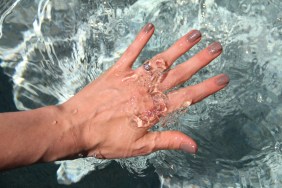

Elizabeth Suda is the founder of sustainable fashion company Article 22. Among the brand’s many worthy designs are the peaceBOMB bracelets, which are made from Vietnam War-era bombs by rural artisans in a part of Laos heavily afflicted by the U.S. bombardment during the Secret War, 1964-1973. Not only are the bracelets incredibly unique, but each purchase supports income generation for artisan families in Naphia Village and helps them create sustainable businesses. A donation is also made to the community bank that funds infrastructure projects including roads, light poles, and electricity for the school and other communal areas. Suda shot some amazing footage in Laos that helps hit home the impact of this project. We spoke to the entrepreneur about what inspired peaceBOMB, the rise of sustainable fashion, what new pieces she’s working on, and more…

The Fashion Spot: Can you tell us a little bit about Peace Bomb and how you came up with the idea to work with Vietnam War scrap metal?
Elizabeth Suda: I was in Ban Naphia on a textile research assignment with the RISE Project of Swiss NGO, Helvetas. The NGO had been working there to bring sustainable electricity through a hydro-powered generator. Now, they were ready to take the next step to help villagers use the new electricity in a way that would help them use their time better and even generate income. In a country where 80% of the population derives a livelihood from subsistence farming, there is little left to sell on the market to earn disposable income. Handcrafts such as textiles are one way for rural communities to generate much needed income that allows them to purchase school uniforms, gas, soap, etc.
I had heard that there was another special craft in this particular village: melting bomb metal and casting it into spoons. I was touched when I saw the artisans transforming bombs dropped by my country into spoons that are useful for their community, which eats a lot of soup!
Transfixed by their creativity and determination to turn negative to positive, I had one of those aha moments: to create a bracelet that would tell their story back home in the U.S. and the world over.
tFS: Was it an easy transition from spoons to bracelets?
ES: At first the artisans were surprised by the idea of making a bracelet. A spoon is used to eat, but a bracelet? After a few attempts they said the bracelet was too difficult to make. Then, two young metal smiths whose fathers taught them the trade figured it out. Now, a year and a half later, they are always motivated to try new things. Before, they were reluctant to take risks and try new things if they weren’t sure it would sell.
tFS: What have been some of the biggest hurdles in bringing Peace Bomb to market?
ES: Telling a complex story succinctly. Laos, the most heavily bombed country in history, is also one of the poorest in SE Asia. By buying back the bombs, consumers help develop the local economy and raise funds to clear unexploded bombs from their farms and fields.
For each peacebomb bracelet sold, ARTICLE 22:
- Pays artisans 4x the local market rate.
- Donates to the village development fund that pays for electricity in communal areas and gives micro loans to poor families.
- Donates the equivalent of the cost of clearing three square meters of bomb-infested land.
tFS: This process must be very rewarding. Can you tell us about anything particularly memorable that has happened in your work with the local artisans?
Seeing the impact of additional funds on artisan families. One of our artisans was in a motorbike accident and because of the extra income that his metal craft generates he was able to pay for his hospital stay and medication. Disposable income gives people freedom and in changes lives.
tFS: You shot some amazing footage while in Laos. How did the experience impact your approach to your fashion business?
ES: For ARTICLE 22, the jewelry is the story and the story is the jewelry. The peaceBOMB bracelet is about bringing the bombs full circle—connecting a war torn past, with the present conditions of an underdeveloped yet culturally rich population, with a future filled with potential. The film and bracelet give the artisans a way to tell the story and give consumers a way to join the artisans, take action, and make a difference. It is about trade not aid.

tFS: You were able to generate the funds needed to shoot the film in just 40 days. Any secrets?
ES: We worked with London-based, Big Balls Films, to crowd source the funds to make the film on Kickstarter.com. We presented a fundraising teaser film about this village craft. One hundred family, friends, and complete strangers were moved to pledge funds to support the making of this film. In return, we sent them postcards from Laos and peaceBOMB bracelets with thanks.
tFS: Peace Bomb is part of your sustainable fashion company, Article 22. Where did that name come from?
ES: ARTICLE 22 is the 22nd article of the United Nations Universal Declaration of Human Rights, which was passed in 1948 and provides inspiration for the work that we do.

tFS: Have you always been interested in design and eco-friendly design in particular?
ES: I studied history and art history. I loved discovering the concept behind a movement or an aesthetic and how it fit in to a larger chronology. At the same time, I have always had a tendency toward creation, whether making handbags or refurbishing footstools. I like the process of transformation. A dirty little secret is my obsession with junk! It always feels like treasure. I love the process of thinking about what something can be—the actual or imagined process of transformation—old to new. The limitation of an existing, but perhaps wounded, object inspires resourcefulness and a different type of creativity than when you have any material at your disposal. It becomes about solving a problem. And then, suddenly, there is not only an object, but also a story.
tFS: Peace Bomb aside, what are some of the materials that go into making your pieces?
ES: Because artisan production methods are traditional – casting from handmade wood and ash molds – we apply sterling silver chain finishings here in NY. The shiny or oxidized silver is a complement to the muted aluminum and allows us to diversify designs.

tFS: Do you come up with the designs or do you work with the artisans to conceive them?
ES: My sister Wallis, a designer and textile artist, and I develop the prototypes and the artisans cast them. The artisans are getting very creative and bring ideas about different polishing and production techniques. We work in collaboration and usually within the limits of their handmade wood and ash molds.
tFS: There has been such a rise in sustainable fashion brands – what do you attribute that to?
ES: Consumers are beginning to think more about how goods are made. They realize that their dollars can make a difference—that what they wear cannot only look good, but also represent that difference. Basically, consumers are more curious. They’re asking questions, which is the only way to create change.

tFS: Can you tell us about some of the new designs you have launching this month?
It’s all about the design. If the form and function don’t translate to the product, it almost doesn’t matter how compelling the story. Design and story must work together.
I’m still in love with the first design—the simple bangle bracelet that brings the bombs full circle. It’s the physical manifestation of buying back the bombs. Because the bangle is so solid, we began to engrave it with the story:
Other bangles from the engraved collection proclaim on the exterior: IheartPEACE and NYheartsPEACE. The heartPEACE Collection will grow as many new locations are added throughout the year.
Two new made-to-order bangles are inspired by traditional peace symbols: the iconic peace sign and peace ribbons. Hand cast in New York, the sterling silver finishings are oxidized and then wrapped around the peaceBOMB bangle. Also new is the identification tag-inspired Tag Wrap Bracelet, which comes with two interchangeable leather cords and a peaceBOMB tag. Great unisex style to layer with bangles and other wraps.
Necklaces are completely new territory for us. Our iconic ARTICLE 22 peacebomb tag is built into the closure of each design. The Story Charm Necklace tells the story from bomb to spoon. The minimalist Tribal Triangle and Bar Tag necklaces are a modern interpretation of indigenous aesthetic inspired in part by village weaving. The sculptural bomb shard necklace is the only piece 100% sterling silver and made in NY. It is cast from a piece of ordnance that was removed by expert bomb technicians from the ground.








